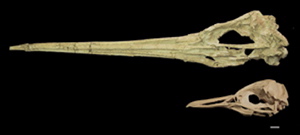 Photo courtesy of the American Museum of Natural History
Photo courtesy of the American Museum of Natural History
Earlier this summer, you may have heard about a surprising paleontological discovery from southern Peru. In a paper published in the journal PNAS, a team of paleontologists announced the discovery of two new species of fossil penguins, Icadyptes and Perudyptes, from an area a few hundred kiometers south of Lima. This desert region is one of the most arid places on the world, but 36 million years ago, it was the shoreline of a balmy, humid world. During this time (the late Eocene), global climate was much warmer than it is today, and neither polar region was especially cold.
So what does this have to do with penguins? The skeletons of these new species have hallmark penguin characteristics shared with living penguins, but they also differ in significant ways: their snouts, for example, are much longer and narrow than any living one. Most interestingly, one of these penguins was enormous-- Icadyptes was nearly 5 feet tall, making it larger than the largest living penguin (the emperor penguin, Aptenodytes forsteri), which is about 4 feet tall.
Size is important because evolutionary biologists have proposed a general trend, called Bergmann's rule, to describe the phenomenon of large animal body size at high latitudes. Birds have mammal-like metabolisms too, and scientists were generally content that penguins demonstrated Bergmann's rule because the largest living penguins were also those that lived in the highest latitudes. The pattern seemed true until the Peruvian discoveries, because the largest fossil penguins were found at high latitudes (with localities in Peru, Argentina, New Zealand). Icadyptes and Perudyptes tell us that the picture is much more complex, and that Bergmann's rule may not apply to penguin evolution-- giant penguins did fine at the equator (that area of Peru was even closer to the equator than it is today, based on paleogeographic reconstructions). Icadyptes and Perudyptes are also all the more important because the skeletons are relatively complete-- in the past, penguins had been described with far fewer comparable parts, a problem which is all to familiar to dinosaur and hominid paleontologists.
If penguins were so successful in warm climates, why don't we have Happy Feet off the coast of California? I'll save that for next post…
![]() Nick Pyenson is a PhD candidate at the University of California, Berkeley, in the department of integrative biology and the museum of paleontology.
Nick Pyenson is a PhD candidate at the University of California, Berkeley, in the department of integrative biology and the museum of paleontology.
